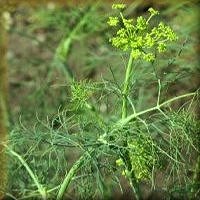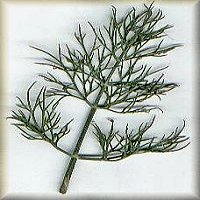

Anethum graveolens


Anethum graveolens
Common Names - Baston Do Diale, Catahva, Datli Boyana, Dereotu, Dille, East Indian Dill, Eneldo, Habbat Helwah, Hinojo, Indian Dill, Inojo, Inondo, King Desertparsley, Sadhab Al Barr, Surva.
Description - Dill (Anethum graveolens) is a fennellike annual or biennial herb of the parsley family. Native to Mediterranean countries and southeastern Europe, dill is now widely cultivated in Europe, India, and North America. The name dill comes from an Old Norse word, dilla, meaning "lull" since they used it to quiet crying babies. Dill was widely used in Greek and Roman times. In the Middle Ages it was thought to have magical properties and was used in witchcraft, love potions and as an aphrodisiac. The whole plant is aromatic. The young leaves and the fully developed green fruit are used for flavoring purposes. Native to Southern Europe and Western Asia, dill grows wild in Spain, Portugal and Italy. It is now cultivated in India, Germany, Rumania, and England and to some extent in North and South America as a commercial crop.
The old Norse name for dill was dilla, which means 'to lull' and the oil from the leaves and especially the seeds, contains a gentle sedative. It is also a soothing digestive and relieves flatulence; dill water has been used to calm colicky babies for centuries'. It is a remedy for flatulence, indigestion and hiccups. It is used in flavouring and pickling cabbage, salting meat, and added to sausages for stuffing, garden dill was very good for treating nightmares, and for flatulence
Edible Parts:
Medicinal Uses - Dill used in its various forms is an Antihalitosis, Aromatic, Carminative, Diuretic, Galactogogue, Stimulant, and a Stomachic! Dill has a very long historyof herbal use going back more than 2,000 years and the use of it's seeds are a common and very effective household remedy for a wide range of digestive problems. An infusion is especially efficacious in treating gripe in babies and flatulence in young children.
The seed is aromatic, carminative, mildly diuretic, galactogogue, stimulant and stomachic. It is also used in the form of an extracted essential oil. Used either in an infusion, or by eating the seed whole, the essential oil in the seed relieves intestinal spasms and griping, helping to settle colic. Chewing the seed improves bad breath. Dill is also a useful addition to cough, cold and flu remedies, it can be used with antispasmodics such as Viburnum opulus to relieve period pains. Dill will also help to increase the flow of milk in nursing mothers and will then be taken by the baby in the milk to help prevent colic.
Pharmacology - The dried ripe fruits yield, on distillation, an essential Volatile oil, consisting mainly of carvone with dihydrocarvone, limonene, a- and b-phellandrene, eugenol, anethole, myristicin, carveole, Flavonoids. It also contains apiol and dill apioll.Dosage - Powder 1-3 gm
or Oil: 1-3 drops with Arka soya, Satapusparka etc.
Contra-indications - Non-toxic, non-irritant and non-sensitizer. Nevertheless, it should be avoided during pregnancy.